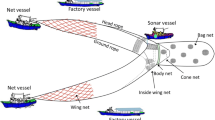Abstract
In a set-net fishery, a leader net and the related nets guide migratory fish into a box chamber net. Many workers have to visit the set-net and haul the box chamber net for harvesting almost every day, while the net-hauling operation in the early morning is dangerous. An automated net-hauling system using a flexible hose net has been proposed as a manpower-saving measure in such operation. The hose net comprises the brick forms of flexible hoses and is installed on the water bottom below the box chamber net. Compressed air is injected from one edge of the hose net to haul the box chamber net gradually, resulting in cornering fish in the other edge. The purpose of the present study is to observe the motion of the hose net and to analyze its formation in water current. Water tank testing was carried out using a 1/100 scale model of a set-net and a hose net. As a result, the middle part of the hose net was steep enough to corner fish in the end of the box chamber net. The two-dimensional formation of the hose net could be approximated by a catenary curve, while a part of the hose net including air inside was likely to have stiffness. The stiffness of the hose including air inside should be taken into account in the following water tank testing. The experimental results will provide the benchmark for the validation of the numerical model, which will be developed in the future. In addition, numerical analysis as well as water tank testing will reveal the tension on the hose net and mooring ropes for the basic design of the hose net in the future. For realizing the prototype of the hose net, special care should be taken for the explosion of air with decreasing pressure in the floating operation and for the leakage of air through the pinholes, which may be generated by sudden change in water pressure on the flexible hoses and their connectors.













Similar content being viewed by others
References
Hiramoto T (1994) Historical changes of set net type in Sagami bay-1. Bull Kanagawa Prefect Fish Exp Stn 15:15–19 (in Japanese)
Hiramoto T (1997) Historical changes of set net type in Sagami bay-2. Big set net type-(1). Bull Kanagawa Prefect Fish Exp Stn 2:25–47 (in Japanese)
Inoue Y, Matsuoka T, Chopin F (2002) Technical guide for set-net fishing. International set net fishing summit in Himi. Kita-Nihon Kaiyo Center Ltd, Hokkaido
Miyamoto H (1952) The theory of set net fishery. Kawade-shobo (in Japanese)
He P, Inoue Y (2010) Large-scale fish traps: gear design, fish behavior, and conservation challenges. In: He P (Eds.) Behavior of marine fishes: capture processes and conservation challenges. Wiley-Blackwell, Ames, Iowa, pp 159–181
Japan International Cooperation Agency (1977) Fishing techniques (1). Compilation of transcript of lectures. Presented at the Training Department SEAFDEC, Bangkok
Kanagawa International Fisheries Training Center and Japan International Cooperation Agency (1978) Outline of fishing gear and method
Ishidoya H (2001) The disaster of fishing gear in set net fishery and its protection. In: Matsuda K (ed) The physics of fishing gear. Seizando-shoten Corporation, Tokyo, pp 186–207
Konigson S, Fjalling A, Berglind M, Lunneryd SG (2013) Male gray seals specialize in raiding salmon traps. Fish Res 148:117–123
Lehtonen E, Suuronen P (2004) Mitigation of seal-induced damage in salmon and whitefish trapnet fisheries by modification of the fish bag. ICES J Mar Sci 61:1195–1200
Suuronen P, Siira A, Kauppinen T, Riikonen R, Lehtonen E, Harjunpaa H (2006) Reduction of seal-induced catch and gear damage by modification of trap-net design: design principles for a seal-safe trap-net. Fish Res 79:129–138
Suuronen P, Chopin F, Glass C, Lokkeborg S, Matsushita Y, Queirolo D, Rihan D (2012) Low impact and fuel efficient fishing—looking beyond the horizon. Fish Res 119–120:135–146
Oitsuki T (2004) The method of net-hauling in set net fishery. Teichi 106:49–56 (in Japanese)
Fukahori K, Kasutani M, Nishenokubi H (1988) On the development of an automatic setnet. Bull Fac Fish Nagasaki Univ 64:45–51 (in Japanese)
Kitazawa D, Mizukami Y, Hirai Y (2012) Numerical analysis of the motion of a flexible hose net used for hauling a box chamber net in set net fishery. Proceedings of the ASME 2012 31st International Conference on Ocean, Offshore and Arctic Engineering, OMAE2012-84151
Tauti M (1934) The force acting on the plane net in motion through the water. Bull Jpn Soc Sci Fish 3(1):1–4
Tauti M (1934) A relation between experiments on model and full scale of fishing net. Bull Jpn Soc Sci Fish 3(4):171–177
Acknowledgements
A part of the present study was supported by the Ministry of Education, Science, Sports and Culture through a Grant-in-Aid for Young Scientists (B) (Research Project Number: 23760777) and a Grant-in-Aid for Scientific Research (B), (Research Project Number: 25289313); further funding was provided by the special fund of the Institute of Industrial Science, University of Tokyo. The authors are indebted to Mr. M. Fujino and Mr. H. Itakura at the Institute of Industrial Science, University of Tokyo. We would like to thank Ajirogyogyou Co. Ltd. for providing us the information of the set-net and the field.
Author information
Authors and Affiliations
Corresponding authors
About this article
Cite this article
Kitazawa, D., Zhang, J., Mizukami, Y. et al. Experimental study on the motion of a flexible hose net used for fish-harvesting in a set-net fishery. J Mar Sci Technol 23, 620–632 (2018). https://doi.org/10.1007/s00773-017-0498-y
Received:
Accepted:
Published:
Issue Date:
DOI: https://doi.org/10.1007/s00773-017-0498-y




